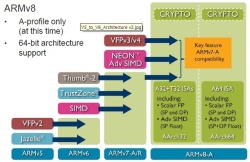ARM targets 64-bit servers
 At its ARM TechCon 2011 conference, UK chip developer ARM has let the cat out of the bag: A64 will be the name given to the 64-bit version of the ARM instruction set. With all the major Linux distributions currently targeting the ARM architecture, the official arrival of the 64 bit version of the instruction set will add an extra level of to their development process. ARM plans to release the ARMv8 specification before the end of 2012, and mass production of the first Systems-on-Chip (SoCs) with ARMv8 cores could start in 2014. The direction is clear: the firm will mainly target servers. Interestingly, ARM's press release quotes a Microsoft representative – in late 2010, insiders had speculated that Microsoft was working on ARM-compatible variants of its server operating system.
At its ARM TechCon 2011 conference, UK chip developer ARM has let the cat out of the bag: A64 will be the name given to the 64-bit version of the ARM instruction set. With all the major Linux distributions currently targeting the ARM architecture, the official arrival of the 64 bit version of the instruction set will add an extra level of to their development process. ARM plans to release the ARMv8 specification before the end of 2012, and mass production of the first Systems-on-Chip (SoCs) with ARMv8 cores could start in 2014. The direction is clear: the firm will mainly target servers. Interestingly, ARM's press release quotes a Microsoft representative – in late 2010, insiders had speculated that Microsoft was working on ARM-compatible variants of its server operating system.
SoC manufacturer Applied Micro Circuits Corporation (AMCC) has already presented an ARMv8 implementation that executes a specially compiled 64-bit ARM version of Linux. However, AMCC implemented this prototype, complete with memory controller and coherent CPU "fabric", in a Xilinx Virtex-6 FPGA. AMCC intends to supply first developer samples of ARMv8 SoCs as early as 2012; they will be produced by contractor TSMC in 40 nanometre or 28 nanometre technology. The company also plans to provide A64-compatible Linux versions of popular server tools for cloud computing such as memcached or Hadoop.

![]() ARMv8 offers the AArch64 execution mode
ARMv8 offers the AArch64 execution mode
Source: ARM
AMCC said that it will release ARMv8 server SoCs called X-Gene which, being "Servers-on-a-Chip", will contain multiple CPU cores with clock speeds of up to 3 GHz as well as a 10 Gigabit Ethernet (10GE) adapter. According to the manufacturer, the coherent connection between the CPU cores will be capable of handling 125 GB of data per second (1 TBit/s), while an external interface for linking multiple ARMv8 SoCs is designed to handle 12.5 GB/s (100 Gb/s). AMCC said that in standby, such SoCs will only consume 0.3 Watts; the manufacturer did not provide any full load or Thermal Design Power (TDP) values. Compared with conventional servers – these are probably x64 or x86 systems with AMD Opteron or Intel Xeon processors –, AMCC said that X-Gene machines "reduce server cost, power and complexity by more than 50 percent". The manufacturer has not revealed how much memory the X-Gene SoC will be able to integrate or how many memory channels, PCI Express ports and storage connections will be available.
AMCC says that X-Gene processors will primarily be used in cloud servers: many internet services don't need much computing power themselves, but will be used simultaneously by thousands or even millions of users during peak times. Cheaper, more compact and more economical servers enable service providers to offer such cloud services at a lower price.
According to ARM, ARMv8 will offer two operational modes, AArch64 and AArch32. AArch64 will make the new A64 instruction set available, while AArch32 will use the ARMv7 instruction set that was introduced in 2005. ARMv8 will retain the full functionality of ARMv7 including TrustZone, virtualisation and NEON SIMD functions. Many further details are included in a presentation that is available to download![]() on the ARM server. For example, the author of the presentation notes that the hypervisor's LPAE (Large Physical Address Extensions) addressing, to become available with the Cortex-A15, will be easily extendable to A64.
on the ARM server. For example, the author of the presentation notes that the hypervisor's LPAE (Large Physical Address Extensions) addressing, to become available with the Cortex-A15, will be easily extendable to A64.
Back in January, ARM's CEO Warren East had dampened A64 development speculations, but he did already mention 2014 then. In his TechCon 2011 presentation, ARM Lead Architect Richard Grisenthwaite said that his company has already worked on this 'biggest architecture change in ARM history' since 2007. The executive expressly pointed out that no actual products have been announced and that, for the time being, ARMv7 will remain the most powerful available ARM architecture, for example in Cortex-A15 processors.
(crve)
![Kernel Log: Coming in 3.10 (Part 3) [--] Infrastructure](/imgs/43/1/0/4/2/6/7/2/comingin310_4_kicker-4977194bfb0de0d7.png)

![Kernel Log: Coming in 3.10 (Part 3) [--] Infrastructure](/imgs/43/1/0/4/2/3/2/3/comingin310_3_kicker-151cd7b9e9660f05.png)
















